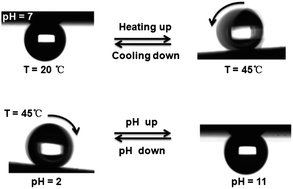Super-hydrophobic surface with switchable adhesion responsive to both temperature and pH†
Abstract
In this article, we report a new super-hydrophobic surface with switchable adhesion that is responsive to both temperature and pH. When the water pH is fixed (pH = 7), a water droplet (4 μL) can roll on the surface at high temperature (45 °C) and be pinned at low temperature (20 °C). Simultaneously, the surface shows strong dependence on the pH of the water droplet, an acid droplet (pH = 2, 4 μL) can roll on the surface while a basic droplet (pH = 11, 4 μL) is pinned when the temperature is constant (45 °C). Reversible transition between the low adhesive rolling state and the high adhesive pinning state can be achieved by simply changing the temperature and/or the pH alternately. The smart effect of the surface is attributed to the cooperation of chemical variation of the poly(N-isopropylacrylamide-co-acrylic acid) P(NIPAAm-co-AAc) and the hierarchical structures on the surface. Such a novel super-hydrophobic surface with dual-responsive adhesion could potentially be used in a wide range of applications with more complex environments, such as biochemical separation, lab-on-chip devices and in situ detection.


 Please wait while we load your content...
Please wait while we load your content...